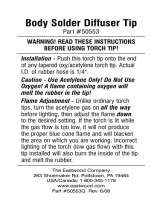
OM-263687 Page 13
2. 3 Years – Parts and Labor
* Toughcut Outfits, Series 30, 32, 35, 36, 40, 46 Regulators, and all
Flowmeters, Flow Gauges, and Flowmeter Regulators
3. 2 Years – Parts and Labor
* Series 250, 820, and Smith-Branded Specialty Gas Regulators
4. 1 Year – Parts and Labor
* Gas Axe Cutting Torches, HVAC/Purge Regulators, 3-Stage Ni-
trogen Low-Pressure Blanketing Regulators, Gas Savers, Gas
Mixers, and all other Oxy-Fuel Products
* SMITH BRANDED PRODUCTS
The Little Torch, Quickbraze Torch, Handi-Heet/Silver Smith Torch
5. 90 Days – Parts and Labor
* Corrosive Service Regulators
Miller’s True Blue) Limited Warranty shall not apply to:
1. Consumable components; oxy-fuel cutting, welding, and heating tips,
or parts that fail due to normal wear.
2. Items furnished by Miller, but manufactured by others. These items are
covered by the manufacturer’s warranty, if any.
3. Equipment that has been modified by any party other than Miller, or
equipment that has been improperly installed, improperly operated or
misused based upon industry standards, or equipment which has not
had reasonable and necessary maintenance, or equipment which has
been used for operation outside of the specifications for the equipment.
MILLER PRODUCTS ARE INTENDED FOR PURCHASE AND USE BY
COMMERCIAL/INDUSTRIAL USERS AND PERSONS TRAINED AND EX-
PERIENCED IN THE USE AND MAINTENANCE OF WELDING EQUIP-
MENT. In the event of a warranty claim covered by this warranty, the exclusive
remedies shall be, at Miller’s option: (1) repair; or (2) replacement; or, where
authorized in writing by Miller in appropriate cases, (3) the reasonable cost of
repair or replacement at an authorized Miller service station; or (4) payment of
or credit for the purchase price (less reasonable depreciation based upon ac-
tual use) upon return of the goods at customer’s risk and expense. Miller’s
option of repair or replacement will be F.O.B., Factory at Appleton, Wisconsin,
or F.O.B. at a Miller authorized service facility as determined by Miller. There-
fore no compensation or reimbursement for transportation costs of any kind
will be allowed. TO THE EXTENT PERMITTED BY LAW, THE REMEDIES
PROVIDED HEREIN ARE THE SOLE AND EXCLUSIVE REMEDIES. IN NO
EVENT SHALL MILLER BE LIABLE FOR DIRECT, INDIRECT, SPECIAL, IN-
CIDENTAL OR CONSEQUENTIAL DAMAGES (INCLUDING LOSS OF
PROFIT), WHETHER BASED ON CONTRACT, TORT OR ANY OTHER LE-
GAL THEORY. ANY EXPRESS WARRANTY NOT PROVIDED HEREIN
AND ANY IMPLIED WARRANTY, GUARANTY OR REPRESENTATION AS
TO PERFORMANCE, AND ANY REMEDY FOR BREACH OF CONTRACT
TORT OR ANY OTHER LEGAL THEORY WHICH, BUT FOR THIS PROVI-
SION, MIGHT ARISE BY IMPLICATION, OPERATION OF LAW, CUSTOM
OF TRADE OR COURSE OF DEALING, INCLUDING ANY IMPLIED WAR-
RANTY OF MERCHANTABILITY OR FITNESS FOR PARTICULAR PUR-
POSE, WITH RESPECT TO ANY AND ALL EQUIPMENT FURNISHED BY
MILLER IS EXCLUDED AND DISCLAIMED BY MILLER.
Some states in the U.S.A. do not allow limitations of how long an implied war-
ranty lasts, or the exclusion of incidental, indirect, special or consequential
damages, so the above limitation or exclusion may not apply to you. This war-
ranty provides specific legal rights, and other rights may be available, but may
vary from state to state. In Canada, legislation in some provinces provides for
certain additional warranties or remedies other than as stated herein, and to
the extent that they may not be waived, the limitations and exclusions set out
above may not apply. This Limited Warranty provides specific legal rights,
and other rights may be available, but may vary from province to province.
Mil oxy-fuel warr 2015-01
















